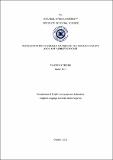DSpace@İHÜ
REPRESENTATION OF FEMALE MADNESS IN THE WOMAN IN WHITE AND LADY AUDLEY’S SECRET
JavaScript is disabled for your browser. Some features of this site may not work without it.
| dc.contributor.author | KIR, Nuran
|
|
| dc.date.accessioned | 2021-06-02T11:18:15Z | |
| dc.date.available | 2021-06-02T11:18:15Z | |
| dc.date.issued | 2019 | |
| dc.identifier.uri | http://hdl.handle.net/11547/8758 | |
| dc.description.abstract | This thesis will examine the connection between madness and women and will explore how women are oppressed in patriarchal society. It will address the ways through which their preoccupations and non-conformism to patriarchy are labeled as “female malady” by looking at Wilkie Collins’ The Woman in White (1859) and Mary Elizabeth Braddon’s Lady Audley’s Secret (1862). Collins and Braddon reflect the role of women in the Victorian society in these two novels which are the most well-known sensation novels of the Victorian period. Also, this study will argue that women’s madness which is seen as woman disease in a patriarchal discourse is exploited as a means of suppression of women in the Victorian society. The introduction includes a history of madness and why it is associated with women especially in the Victorian period and why it is feminized by drawing mainly upon Elaine Showalter’s The Female Malady (1985). The first chapter will explore how women’s madness is socially constructed and defined and will argue that its treatment is only through considering mad women as social threat and outcast, as best manifest in Collins’ The Woman in White. In other words, this chapter will demonstrate how madness is re-engineered to oppress non-conformist women in the Victorian patriarchal society. Chapter Two will examine the ways through which women’s madness is reflected in Mary Elizabeth Braddon’s Lady Audley’s Secret. In this chapter, unlike the first chapter, it will be argued that female characters of the novel resort to madness as a gateway to their liberation and a revolt against oppressive patriarchal conventions of the time society rules. Conclusion will be devoted to comparing and contrasting the ways through which madness is portrayed in the two novels in question. The thesis will conclude that madness is not biologically or physically female disease, instead it is a kind of veil to cover up suppression of women in a society dominated by masculine and patriarchal norms. | tr_TR |
| dc.subject | female madness | tr_TR |
| dc.subject | Victorian women | tr_TR |
| dc.subject | sensation novels | tr_TR |
| dc.subject | The Woman in White, Lady Audley’s Secret | tr_TR |
| dc.title | REPRESENTATION OF FEMALE MADNESS IN THE WOMAN IN WHITE AND LADY AUDLEY’S SECRET | tr_TR |
| dc.type | Thesis | tr_TR |
Bu öğenin dosyaları:
Bu öğe aşağıdaki koleksiyon(lar)da görünmektedir.
-
Tezler -- Thesis [3438]
